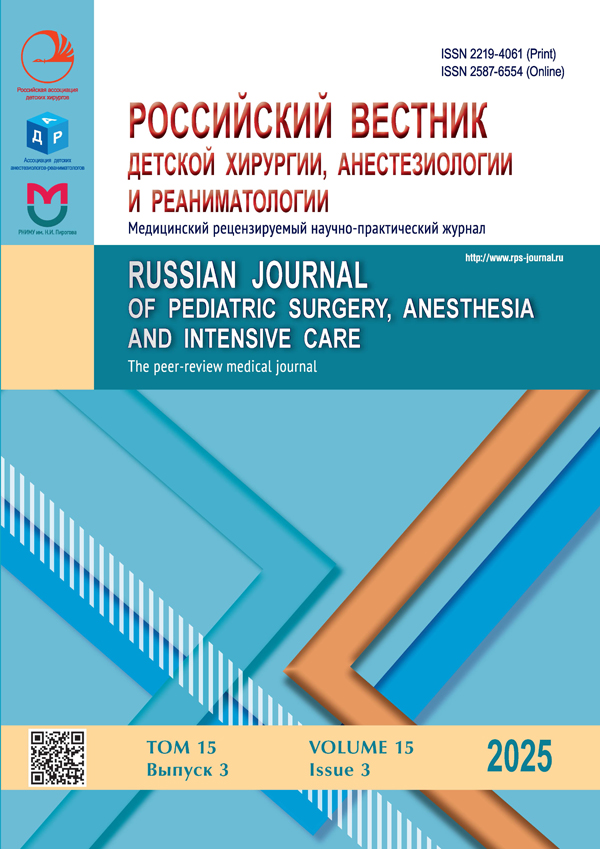Fibro-adipose vascular anomaly in an adolescent: a case report
- Authors: Garbuzov R.V.1, Feoktistova E.V.1,2, Mylnikov A.A.1, Stakhova M.B.1, Razumovskiy A.Y.2
-
Affiliations:
- Russian Children’s Clinical Hospital — branch of the N.I. Pirogov Russian National Research Medical University
- Pirogov Russian National Research Medical University
- Issue: Vol 15, No 3 (2025)
- Pages: 379-388
- Section: Case reports
- URL: https://journal-vniispk.ru/2219-4061/article/view/343617
- DOI: https://doi.org/10.17816/psaic1916
- EDN: https://elibrary.ru/SDHTDM
- ID: 343617
Cite item
Full Text
Abstract
Fibro-adipose vascular anomaly is a relatively rare and only recently described disorder with distinctive clinical, radiological, and pathomorphological features. It is crucial for physicians to be fully aware of this condition to ensure timely diagnosis and early initiation of treatment. This article presents the clinical case of a 17-year-old female with fibro-adipose vascular anomaly of the right leg. At the age of 7, she developed a painful lesion in the leg. Over time, the lesion progressively increased in size, accompanied by limb hypotrophy and restricted ankle joint mobility. At the healthcare facility of her place of residence, multiple ultrasound examinations and computed tomography angiography were performed, which led to the diagnosis of mixed angiodysplasia of the right leg. Conservative measures, including physical therapy, compression garments, and orthopedic footwear, were ineffective. Disability was established at the age of 13. At 17, the patient was admitted to the Russian Children’s Clinical Hospital (Moscow). Examination revealed shortening of the right leg and foot, a firm painful mass in the upper third of the leg, hypotrophy of the thigh and calf muscles, and ankle contracture. Ultrasound examination revealed a hyperechoic lesion with indistinct outer margins in the muscles of the upper third of the leg, containing abnormally formed venous vessels with multiple phleboliths. Magnetic resonance imaging of this area confirmed the presence of vascular malformation. Angiography was additionally performed to clarify the angioarchitecture of the lesion and determine the possible extent of resection, leading to the diagnosis Q27.8—fibro-adipose vascular anomaly of the right leg. Given the impossibility of radical surgery due to subtotal involvement of the posterior muscle group of leg, the high risk of progression, pain, and impaired function, anti-proliferative therapy with sirolimus was initiated. Rehospitalization was scheduled after one year to assess treatment efficacy and reconsider surgical options. This case illustrates the challenges of delayed diagnosis, where long-term unrecognized disease progression resulted in disability and precluded one-stage radical treatment.
Full Text
##article.viewOnOriginalSite##About the authors
Roman V. Garbuzov
Russian Children’s Clinical Hospital — branch of the N.I. Pirogov Russian National Research Medical University
Author for correspondence.
Email: 9369025@mail.ru
ORCID iD: 0000-0002-5287-7889
SPIN-code: 7590-2400
MD, Dr. Sci. (Medicine)
Russian Federation, MoscowElena V. Feoktistova
Russian Children’s Clinical Hospital — branch of the N.I. Pirogov Russian National Research Medical University; Pirogov Russian National Research Medical University
Email: 9433672@mail.ru
ORCID iD: 0000-0003-2348-221X
SPIN-code: 4700-3655
MD, Cand. Sci. (Medicine), Assistant Professor
Russian Federation, Moscow; MoscowAndrei A. Mylnikov
Russian Children’s Clinical Hospital — branch of the N.I. Pirogov Russian National Research Medical University
Email: angio.doctor@mail.ru
ORCID iD: 0000-0003-3317-3058
SPIN-code: 2225-1987
MD, Cand. Sci. (Medicine)
Russian Federation, MoscowMarina B. Stakhova
Russian Children’s Clinical Hospital — branch of the N.I. Pirogov Russian National Research Medical University
Email: marin-stakhov@ya.ru
ORCID iD: 0009-0000-5675-8353
SPIN-code: 5391-7175
Russian Federation, Moscow
Aleksander Yu. Razumovskiy
Pirogov Russian National Research Medical University
Email: 1595105@mail.ru
ORCID iD: 0000-0002-9497-4070
SPIN-code: 3600-4701
MD, Dr. Sci. (Medicine), Professor, Corresponding Member of the Russian Academy of Sciences
Russian Federation, MoscowReferences
- Alomari AI, Spencer SA, Arnold RW, et al. Fibro-adipose vascular anomaly: clinical-radiologic-pathologic features of a newly delineated disorder of the extremity. J Pediatr Orthop. 2014;34(1):109–117. doi: 10.1097/BPO.0b013e3182a1f0b8
- Luks VL, Kamitaki N, Vivero MP, et al. Lymphatic and other vascular malformative/overgrowth disorders are caused by somatic mutations in PIK3CA. J Pediatr. 2015;166(4):1048–1054. doi: 10.1016/j.jpeds.2014.12.069
- Narbutov AG, Sukhov MN, Serkov II, et al. Fibro-adipose vascular anomaly is a new diagnosis in the practice of pediatric vascular surgeon. Experience in diagnostic and treatment. Russian Journal of Pediatric Surgery. 2020;24(1):11–15. doi: 10.18821/1560-9510-2020-24-1-11-15. EDN: PNHEDV
- Uller W, Fishman SJ, Alomari AI. Overgrowth syndromes with complex vascular anomalies. Semin Pediatr Surg. 2014;23(4):208–215. doi: 10.1053/j.sempedsurg.2014.06.013
- Lipede C, Nikkhah D, Ashton R, et al. Management of fibro-adipose vascular anomalies (FAVA) in paediatric practice. Int Open Access J Surg Reconstr. 2021;29:71–81. doi: 10.1016/j.jpra.2021.05.002
- Amameh M, Shaikh R. Clinical and imaging features in fibro-adipose vascular anomaly (FAVA). Pediatr Radiol. 2020;50:380–387. doi: 10.1007/s00247-019-04571-6
- Parmar B, Joseph JS, Khalil-Khan A, et al. Fibro-adipose vascular anomaly: a case report and literary review. Cureus. 2022;14(10):e30757. doi: 10.7759/cureus.30757
- Wang H, Xie C, Lin W, et al. MRI-based radiomics in distinguishing Kaposiform hemangioendothelioma (KHE) and fibro-adipose vascular anomaly (FAVA) in extremities: A preliminary retrospective study. J Clin Pediatr Surg. 2022;7(21):668–674. doi: 10.1016/j.jpedsurg.2022.02.031
- Merrow AC, Gupta A, Patel MN, Adams DM. 2014 revised classification of vascular lesions from the international society for the study of vascular anomalies: radiologic-pathologic update. Radiographics. 2016;36(5):1494–516. doi: 10.1148/rg.2016150197
- Lin JY, Ochmanek E, Tchanque-Fossuo CN, et al. A comparative review of fibroadipose vascular anomaly and PTEN hamartoma syndrome of the soft tissue: a case review of FAVA and PHOST. J Vasc Anom. 2022;3(2):e042. doi: 10.1097/JOVA.0000000000000042
- Wang H, Xie C, Lin W, et al. Fibro-adipose vascular anomaly (FAVA) — diagnosis, staging and management. Orphanet J Rare Dis. 2023;18:347. doi: 10.1186/s13023-023-02961-6
- Shaikh R, Alomari AI, Kerr CL, et al. Cryoablation in fibro-adipose vascular anomaly (FAVA): a minimally invasive treatment option. Pediatr Radiol. 2016;46(8):1179–1186. doi: 10.1007/s00247-016-3576-0
- Donyush EK, Kondrashova ZA, Polyaev YuA, et al. Sirolimus for the treatment of vascular anomalies in children. Russian Journal of Pediatric Hematology and Oncology. 2020;7(3):22–31. doi: 10.21682/2311-1267-2020-7-3-22-31 EDN: WKDTJC
- Wang KK, Glenn RL, Adams DM, et al. Surgical management of fibroadipose vascular anomaly of the lower extremities. J Pediatr Orthop. 2020;40(3):e227–e236. doi: 10.1097/BPO.0000000000001406
- Xie C, Wang H, Guo Z, et al. A novel endoscopic approach to fibroadipose vascular anomaly. J Pediatr Surg. 2025;60(2):162064. doi: 10.1016/j.jpedsurg.2024.162064
- Goldenberg DC, Zatz RF. Surgical treatment of vascular anomalies. Dermatol Clin. 2022;40(4):473–480. doi: 10.1016/j.det.2022.06.006
Supplementary files













